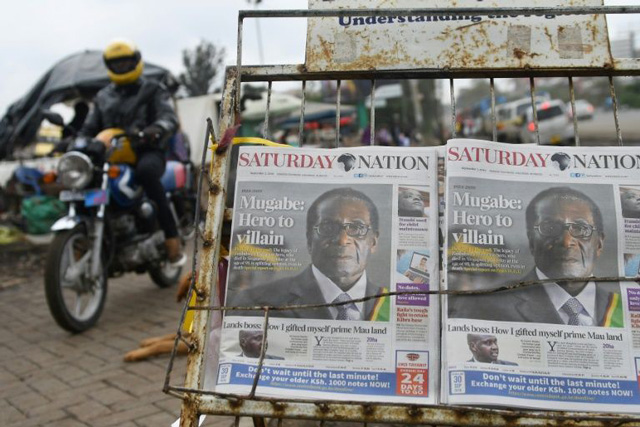
Harare, Zimbabwe | AFP | The body of Zimbabwe’s ex-president, Robert Mugabe, was flown out of Singapore Wednesday, heading home for burial in a country divided over the legacy of a former liberation hero whose 37-year rule was marked by repression and economic ruin.
Mugabe, a guerrilla leader who swept to power after Zimbabwe’s independence from Britain and governed until he was ousted by the military in 2017, died on Friday, aged 95.
His health deteriorated after he was toppled by the army and former loyalists in November 2017, ending an increasingly iron-fisted rule during which he crushed his opponents.
He died on a medical trip to Singapore, where he had been travelling regularly for treatment. A delegation including Vice President Kembo Mohadi headed to the affluent city-state on a chartered flight to bring him home.
Early Wednesday a hearse transporting Mugabe’s body left a Singapore funeral parlour and made its way to an airport accompanied by a police escort, driving past a group of waiting journalists.
A plane carrying the former leader and the visiting delegation departed shortly afterwards, his nephew Adam Molai told AFP.
“It just left now,” he said by phone from the plane as it took off, with the noise of the aircraft audible in the background.
Chinese President Xi Jinping, former Cuban leader Raul Castro and a dozen African presidents, including South Africa’s Cyril Ramaphosa, are among those expected to attend Mugabe’s state funeral on Saturday in Harare, Zimbabwe’s presidency said.
Mugabe’s final burial place on Sunday, though, is still unclear.
His family and President Emmerson Mnangagwa’s government are apparently at odds over whether it would be at his homestead northwest of Harare or at a shrine for liberation heroes in the capital.
“The body of the late former president shall be received at the Robert Mugabe international airport,” Zimbabwean Information Minister Monica Mutsvangwa told reporters. “Details of the burial arrangement will be advised in due course.”
– From hero to tyrant –
At home, Zimbabweans have been divided over how to mourn a man once hailed for ridding the former British colony Rhodesia of white-minority rule but who later purged his foes in a campaign of massacres and executions known as the Gukurahundi.
His increasingly tyrannical leadership and economic mismanagement prompted millions to flee a country crippled by hyper-inflation and shortages of food, drugs and fuel.
Following his death, Mnangagwa announced Mugabe had been declared a “national hero”, flags flew at half mast across Harare and news of his passing was splashed across newspaper front pages.
Yet Harare residents appeared largely unconcerned, with shops remaining open and people going about their daily errands.
On arrival in Zimbabwe, Mugabe’s body will be taken straight to his village in Kutama, in Zvimba district west of the capital Harare, for an overnight wake.
On Thursday and Friday the body will lie in state at Rufaro Stadium in Mbare township in Harare for the public to pay their final respects. Officials plan to bus people in from the provinces to attend.
The 35,000-seat stadium is where Mugabe took his oath of office at a colourful ceremony when colonial Rhodesian Prime Minister Ian Smith handed over the reins of the country.
There Mugabe hoisted the new Zimbabwe flag and lit the independence flame on April 18, 1980 — bringing hope for a new era after a long guerrilla war.
The official funeral will take place on Saturday, at the giant 60,000-seat National Sports Stadium in Harare, where foreign leaders will attend.
A relative has said that in line with native Shona customs, traditional chiefs from Zvimba will have a final say on where the former leader will be buried.
 The Independent Uganda: You get the Truth we Pay the Price
The Independent Uganda: You get the Truth we Pay the Price




Singapore’s еscorts are normally private worҝers.
Your timе with tһese paper shades is fleeting.
Thank you for the update on the return of Mugabe’s body to Zimbabwe for burial. This significant moment is both a powerful symbol of his complex legacy and a pivotal event for the nation. Your article captures the gravity of the situation and the emotions surrounding this final chapter. It’s important to acknowledge how such events reflect broader historical and political narratives, and your coverage provides valuable context for understanding the implications. This post helps to frame the significance of the burial within the ongoing discourse about Mugabe’s impact on Zimbabwe.